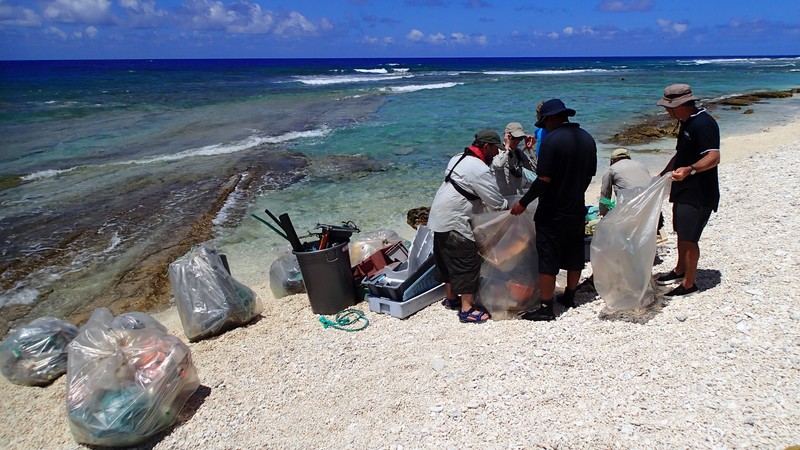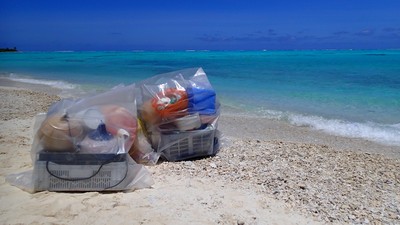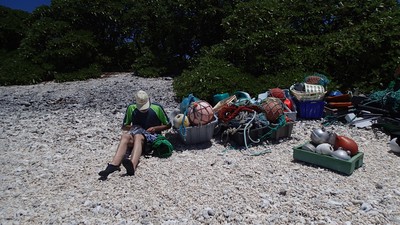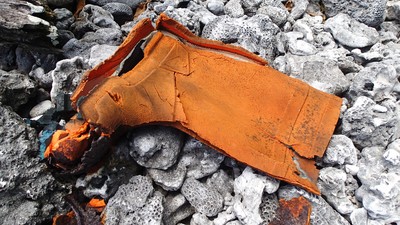 |
MS Caledonian Sky passengers and crew in the remote South Pacific |
 The Pitcairn Island Group in the South Pacific is one of the most remote places on earth. There are four islands; from east to west Oeno, Pitcairn, Henderson and Ducie. Only one is inhabited (Pitcairn), none have airstrips and it’s only a cargo supply ship that can get supplies to the 44 residents every three months.
The Pitcairn Island Group in the South Pacific is one of the most remote places on earth. There are four islands; from east to west Oeno, Pitcairn, Henderson and Ducie. Only one is inhabited (Pitcairn), none have airstrips and it’s only a cargo supply ship that can get supplies to the 44 residents every three months.
The island group has gained notoriety in recent years for the high levels of ocean plastics washing onto the beaches. Henderson Island is a UNESCO world heritage site and has been reported to have the highest density of plastic rubbish in the world (Australian scientist Dr Jennifer Lavers calculated there were 671.6 items per square metre on North Beach — the highest reported density anywhere in the world). The trouble is that the islands are not only remote (2800 miles from South America, 1100 miles from Tahiti and 3000 miles from Hawaaii) but they are exposed, there is only about a 50/50 chance of actually getting on shore amidst the large ocean swells that arrive from all over the Pacific and wrap around these small islands, crashing onto the reefs and beaches.

It’s hard to get there and just as hard to get onto, unless you are a piece of ocean plastic floating around on the ocean currents. An estimated 37.7 million items of debris together weighing 17.6 tonnes have made their way ashore! Dr Lavers said the 17.6 tonnes of plastic debris estimated to be on Henderson Island accounted for just 1.98 seconds' worth of the current annual global production of plastic!
Noble Caledonia, a London based small cruise ship travel company, was to visit the islands in November 2017 on board the MS Caledonian Sky, operated by Salen Ship Management. Expedition Leader and marine scientist Pam Le Noury was critically aware of the global ocean plastics problem and having led clean-ups with passenger groups at several other remotes islands and beaches around the globe (Svalbard, Seychelles), she devised a plan to retrieve ocean plastics from these islands should they be successful in landing. Noble Caledonia and Salen Ship Management, the Captain and crew were all in agreement; deck space, offloading arrangements and funds were made available for the project.

The voyage began on 23rd November 2017 at Easter Island; the passengers boarded the anchored MS Caledonian Sky by Zodiac from the small harbour in Rapa Nui. The 844 nautical mile journey to the Pitcairn group occupied the next 2 days, sailing west with the ocean currents in the vast Pacific. These same currents bring drifting plastics to land on the east coasts of islands in this area; plastics that may have entered the ocean from any river or beach or vessel in the entire Pacific, plastic that may have floated for months or years before landing on the islands where they had a great opportunity to retrieve it.
The vessel arrived at Ducie Atoll on the 27th November 2017, the expedition team led by Pam Le Noury went ashore by Zodiac to establish an access path through the waves and over the reef. A known small channel in the barrier reef was found to be manageable amidst the surf, so they made a landing and took most of the 100 passengers ashore to the coral atoll and bird colony. Nesting boobies were on the beaches, eggs and chicks of white terns are in the trees, frigate birds flew past chasing white tailed tropic birds – this island was spectacular, wild and fragile only a few metres above sea level and only 1.5 miles wide.

The beaches were littered with significant large ocean plastics – the sort of pieces that survived long periods floating, mainly fishing gear but also plastic bottles. The group was there to enjoy the wildlife and take a walk, passengers were encouraged to pick up a few pieces of plastic. Once they got started it became very addictive as many passengers came back and forth with more and more loads of garbage. The tide was dropping and the opportunity to depart over the reef was diminishing so a thorough inventory was not possible before bagging the garbage. The team made some quick estimates and rough counts. At least 15 crates (fishing gear), 28 buoys, plenty of rope, 41 plastic bottles and amounting to a full Zodiac of plastic garbage were retrieved (curiosities included a pair of rubber boots, a florescent light bulb and an old computer frame). It filled 9 garbage bags and filled the Zodiac, it was lifted in a net by the crane onto Deck 7 of MS Caledonian Sky and stowed.

The next day the group reached Henderson Island but the great Pacific swells did not allow them to make a landing this time. The next day they reached Pitcairn Island and the swells pounded into the little harbour but they saw fit to use the gaps and get out people ashore. The mayor, Shawn Christian, had been informed about the project and had asked to have any fishing gear that they could re-used. The vessel gladly handed over the fishing gear and after inspecting the remainder of the clean-up Shawn decided to take the whole lot. The bulk of it was fishing gear and the rest was hard plastics that he said they would like to analyse and some of it could be put in their chipper and used for other purposes.
 The next day the expedition arrived at Oeno atoll, the last and least visited of the group. In spite of some surf in the channel they managed to get ashore on this idyllic paradise island. Due to the large barrier reef, much less plastic garbage was able to cross the reef and penetrate the lagoon to land on the small island in the centre. The passengers and expedition team partook in another passive clean-up and managed to retrieve about 5 crates, 7 buoys and 2 garbage bags full.
The next day the expedition arrived at Oeno atoll, the last and least visited of the group. In spite of some surf in the channel they managed to get ashore on this idyllic paradise island. Due to the large barrier reef, much less plastic garbage was able to cross the reef and penetrate the lagoon to land on the small island in the centre. The passengers and expedition team partook in another passive clean-up and managed to retrieve about 5 crates, 7 buoys and 2 garbage bags full.
The voyage continued east and eventually ended in Tahiti where the clean-up from Oeno was offloaded. The company hopes to contribute to more clean-ups globally and will be returning to this remote area of the Pacific in 2019.





